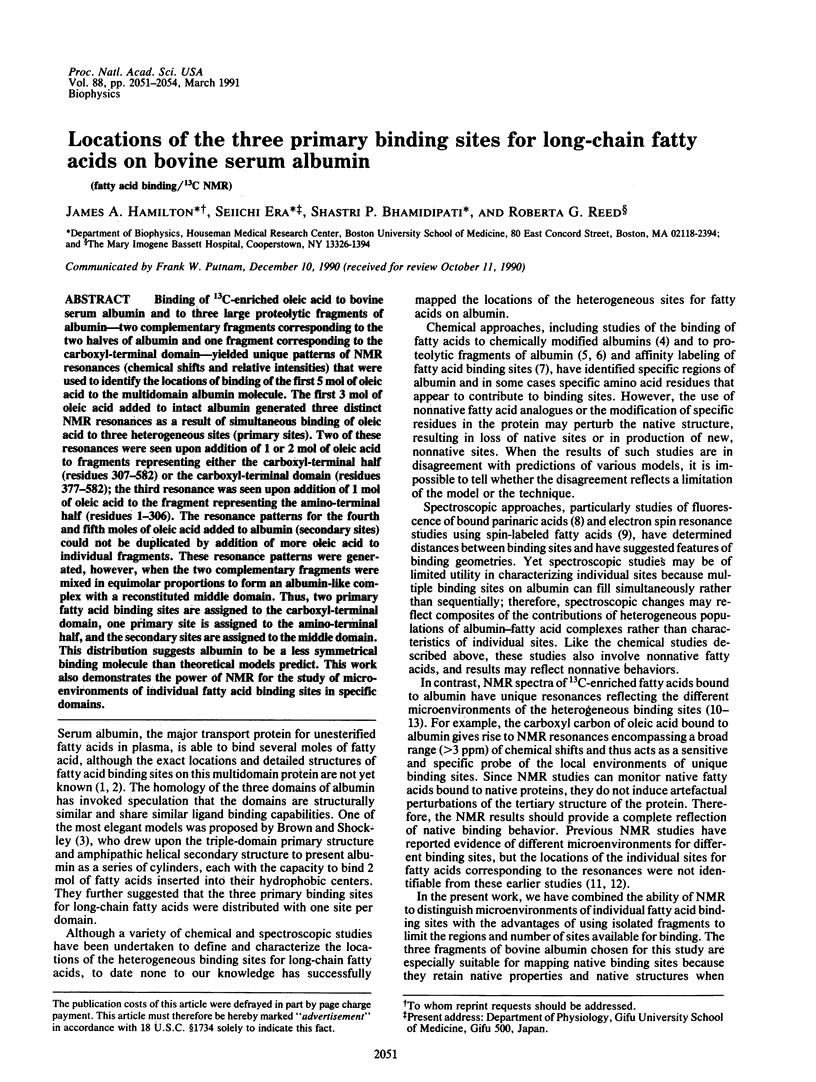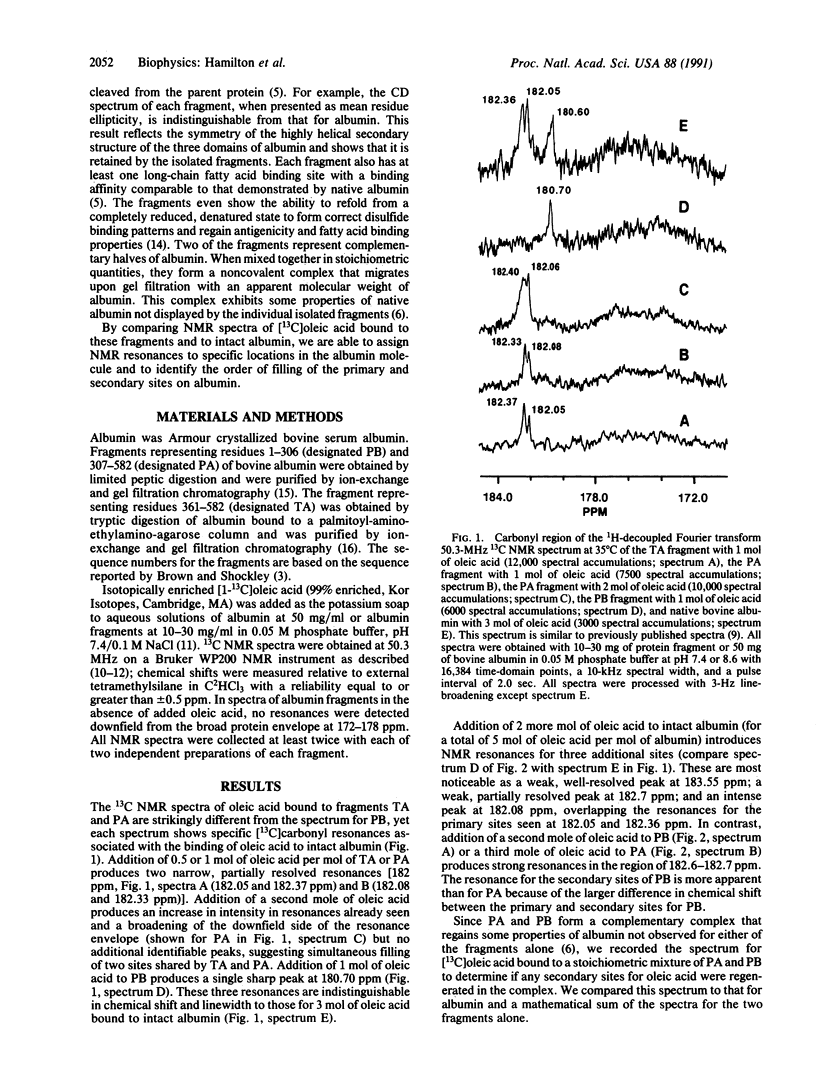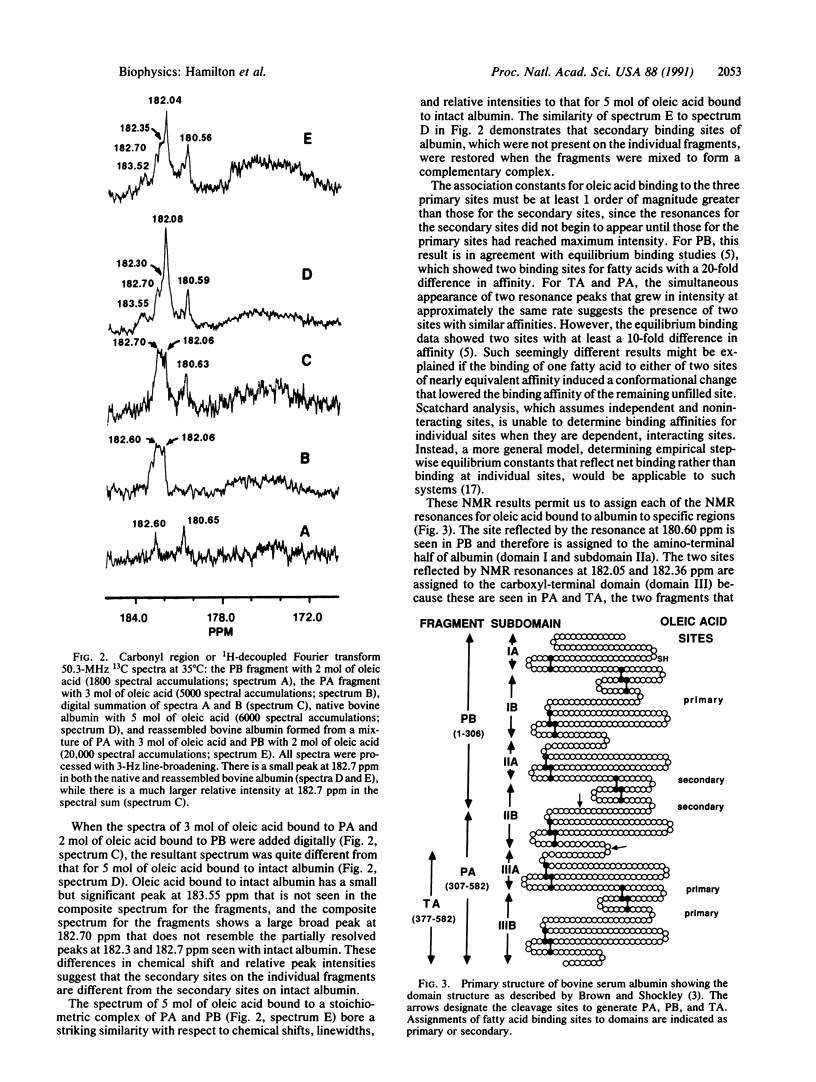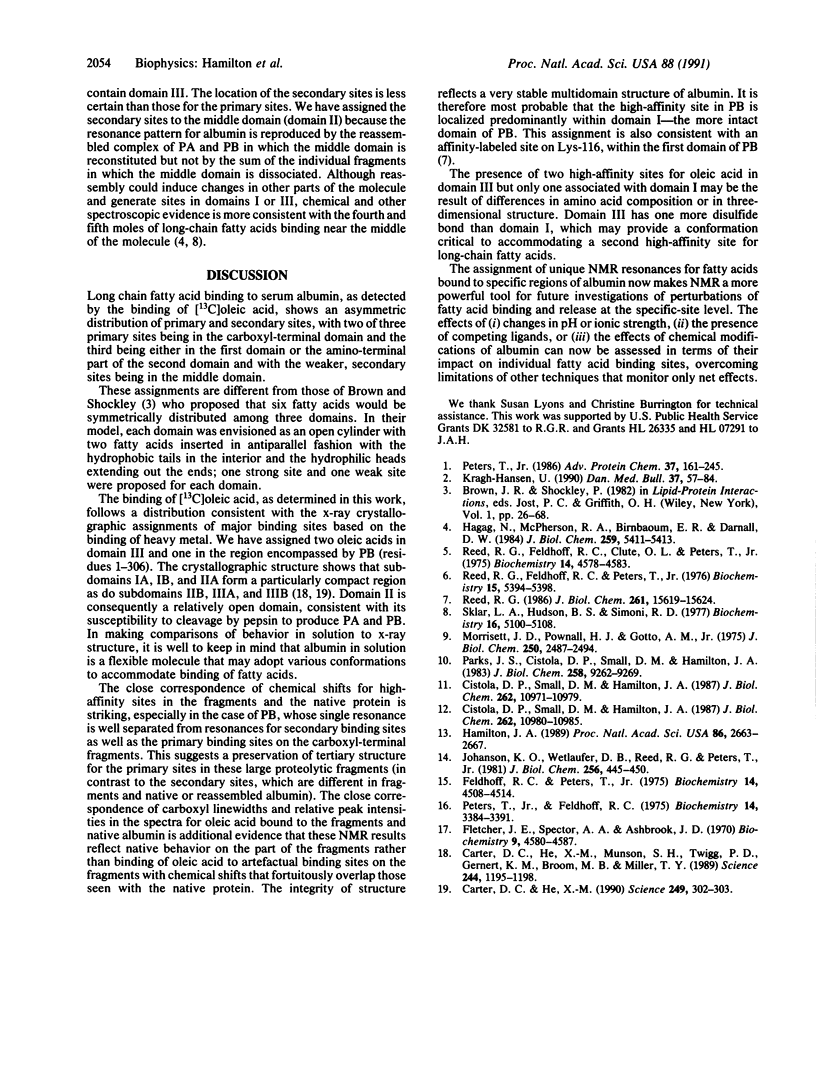Abstract
Binding of 13C-enriched oleic acid to bovine serum albumin and to three large proteolytic fragments of albumin--two complementary fragments corresponding to the two halves of albumin and one fragment corresponding to the carboxyl-terminal domain--yielded unique patterns of NMR resonances (chemical shifts and relative intensities) that were used to identify the locations of binding of the first 5 mol of oleic acid to the multidomain albumin molecule. The first 3 mol of oleic acid added to intact albumin generated three distinct NMR resonances as a result of simultaneous binding of oleic acid to three heterogeneous sites (primary sites). Two of these resonances were seen upon addition of 1 or 2 mol of oleic acid to fragments representing either the carboxyl-terminal half (residues 307-582) or the carboxyl-terminal domain (residues 377-582); the third resonance was seen upon addition of 1 mol of oleic acid to the fragment representing the amino-terminal half (residues 1-306). The resonance patterns for the fourth and fifth moles of oleic acid added to albumin (secondary sites) could not be duplicated by addition of more oleic acid to individual fragments. These resonance patterns were generated, however, when the two complementary fragments were mixed in equimolar proportions to form an albumin-like complex with a reconstituted middle domain. Thus, two primary fatty acid binding sites are assigned to the carboxyl-terminal domain, one primary site is assigned to the amino-terminal half, and the secondary sites are assigned to the middle domain. This distribution suggests albumin to be a less symmetrical binding molecule than theoretical models predict. This work also demonstrates the power of NMR for the study of microenvironments of individual fatty acid binding sites in specific domains.
Full text
PDF



Selected References
These references are in PubMed. This may not be the complete list of references from this article.
- Carter D. C., He X. M., Munson S. H., Twigg P. D., Gernert K. M., Broom M. B., Miller T. Y. Three-dimensional structure of human serum albumin. Science. 1989 Jun 9;244(4909):1195–1198. doi: 10.1126/science.2727704. [DOI] [PubMed] [Google Scholar]
- Carter D. C., He X. M. Structure of human serum albumin. Science. 1990 Jul 20;249(4966):302–303. doi: 10.1126/science.2374930. [DOI] [PubMed] [Google Scholar]
- Cistola D. P., Small D. M., Hamilton J. A. Carbon 13 NMR studies of saturated fatty acids bound to bovine serum albumin. I. The filling of individual fatty acid binding sites. J Biol Chem. 1987 Aug 15;262(23):10971–10979. [PubMed] [Google Scholar]
- Cistola D. P., Small D. M., Hamilton J. A. Carbon 13 NMR studies of saturated fatty acids bound to bovine serum albumin. II. Electrostatic interactions in individual fatty acid binding sites. J Biol Chem. 1987 Aug 15;262(23):10980–10985. [PubMed] [Google Scholar]
- Feldhoff R. C., Peters T., Jr Fragments of bovine serum albumin produced by limited proteolysis. Isolation and characterization of peptic fragments. Biochemistry. 1975 Oct 7;14(20):4508–4514. doi: 10.1021/bi00691a027. [DOI] [PubMed] [Google Scholar]
- Fletcher J. E., Spector A. A., Ashbrook J. D. Analysis of macromolecule--ligand binding by determination of stepwise equilibrium constants. Biochemistry. 1970 Nov 10;9(23):4580–4587. doi: 10.1021/bi00825a018. [DOI] [PubMed] [Google Scholar]
- Hagag N., McPherson R. A., Birnbaum E. R., Darnall D. W. Anthraniloyl-tyrosine 411 as a spectroscopic probe of fatty acid binding to human serum albumin. J Biol Chem. 1984 May 10;259(9):5411–5413. [PubMed] [Google Scholar]
- Hamilton J. A. Medium-chain fatty acid binding to albumin and transfer to phospholipid bilayers. Proc Natl Acad Sci U S A. 1989 Apr;86(8):2663–2667. doi: 10.1073/pnas.86.8.2663. [DOI] [PMC free article] [PubMed] [Google Scholar]
- Johanson K. O., Wetlaufer D. B., Reed R. G., Peters T., Jr Refolding of bovine serum albumin and its proteolytic fragments. Regain of disulfide bonds, secondary structure, and ligand-binding ability. J Biol Chem. 1981 Jan 10;256(1):445–450. [PubMed] [Google Scholar]
- Kragh-Hansen U. Structure and ligand binding properties of human serum albumin. Dan Med Bull. 1990 Feb;37(1):57–84. [PubMed] [Google Scholar]
- Morrisett J. D., Pownall H. J., Gotto A. M., Jr Bovine serum albumin. Study of the fatty acid and steroid binding sites using spin-labeled lipids. J Biol Chem. 1975 Apr 10;250(7):2487–2494. [PubMed] [Google Scholar]
- Parks J. S., Cistola D. P., Small D. M., Hamilton J. A. Interactions of the carboxyl group of oleic acid with bovine serum albumin: a 13C NMR study. J Biol Chem. 1983 Aug 10;258(15):9262–9269. [PubMed] [Google Scholar]
- Peters T., Jr, Feldhoff R. C. Fragments of bovine serum albumin produced by limited proteolysis. Isolation and characterization of tryptic fragments. Biochemistry. 1975 Jul 29;14(15):3384–3391. doi: 10.1021/bi00686a015. [DOI] [PubMed] [Google Scholar]
- Peters T., Jr Serum albumin. Adv Protein Chem. 1985;37:161–245. doi: 10.1016/s0065-3233(08)60065-0. [DOI] [PubMed] [Google Scholar]
- Reed R. G., Feldhoff R. C., Clute O. L., Peters T., Jr Fragments of bovine serum albumin produced by limited proteolysis. Conformation and ligand binding. Biochemistry. 1975 Oct 21;14(21):4578–4583. doi: 10.1021/bi00692a004. [DOI] [PubMed] [Google Scholar]
- Reed R. G., Feldhoff R. C., Peters T., Jr Fragments of bovine serum albumin produced by limited proteolysis: complementary behavior of two large fragments. Biochemistry. 1976 Nov 30;15(24):5394–5398. doi: 10.1021/bi00669a028. [DOI] [PubMed] [Google Scholar]
- Reed R. G. Location of long chain fatty acid-binding sites of bovine serum albumin by affinity labeling. J Biol Chem. 1986 Nov 25;261(33):15619–15624. [PubMed] [Google Scholar]
- Sklar L. A., Hudson B. S., Simoni R. D. Conjugated polyene fatty acids as fluorescent probes: binding to bovine serum albumin. Biochemistry. 1977 Nov 15;16(23):5100–5108. doi: 10.1021/bi00642a024. [DOI] [PubMed] [Google Scholar]


